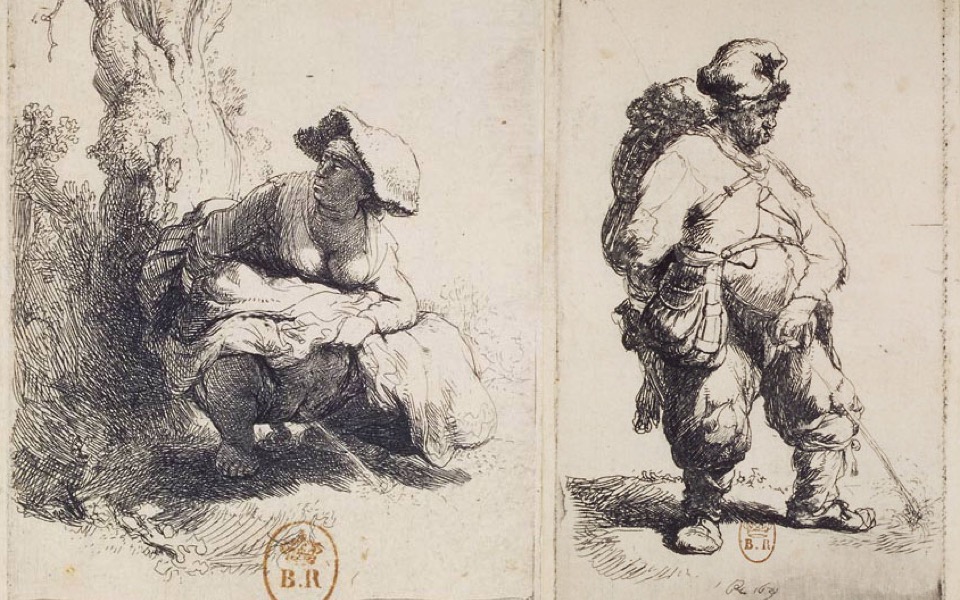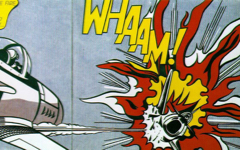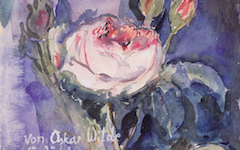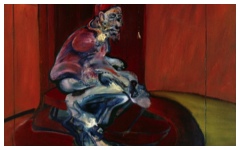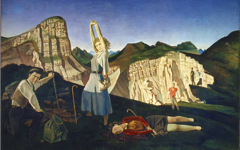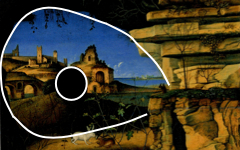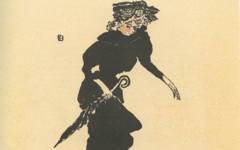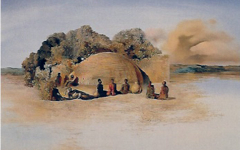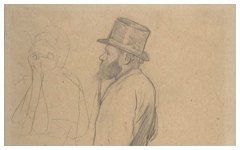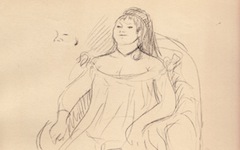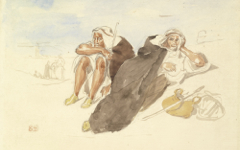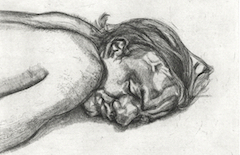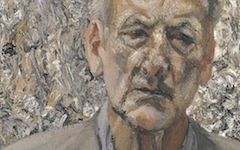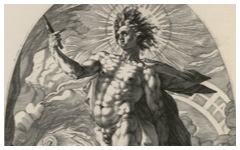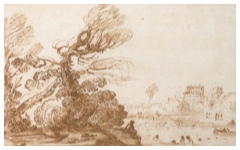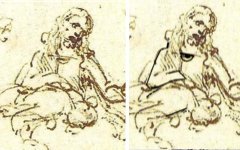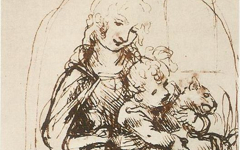Veiled Faces
This may be the most controversial suggestion because it has been proposed by many lay experts before and denounced by the academics every time as foolish and mistaken. Certainly, there have been some outlandish claims but to dismiss all of them, some of them highly important, is equally foolish. This is the truth: under the apparent surface of many great paintings, especially landscapes, is a hidden face. Sometimes it is the artist’s, sometimes an admired poet’s or, as in most instances, still anonymous. Academics comment in disagreement “that you can see what you want to see” but the self-evident examples shown here make that response untenable. Practising artists, however, when shown these examples have unanimously agreed with our perception, many with comments like “That’s how an artist thinks.”
Most Recent Articles
All Articles (Alphabetical by Artist, then Title)
Even anonymous art can be enjoyed through EPPH's methodology
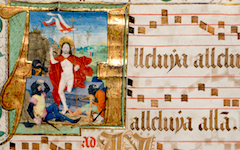
Anonymous Antiphony from Lausanne (c.1485-90)
In a short addendum to Part 1, see how Balthus conveyed his alter ego
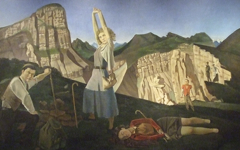
Balthus’ The Mountain (1937) Part 2
Learn how to deconstruct a portrait by Balthus using a few simple principles
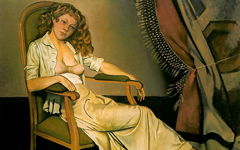
Balthus’ The White Skirt (1937)
Why would a great poet just depict fruit on a platter with no other content or meaning? The answer: they wouldn't.

Bonnard’s Fruit on a Red Tablecloth (c.1943)
How Bonnard turned his creative process into a scene in modern Paris
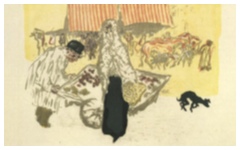
Bonnard’s The Pushcart (c.1897)
This masterpiece, like many before and since, must have been the source of inspiration for Picasso's Cubism. As unlikely as that may sound, it all depends on what you can see in The Birth of Venus that experts never have. You'll be one of the first...
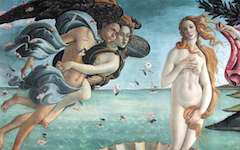
Botticelli’s Birth of Venus (1484-6): Part Two
Unless you knew that there might be a self-portrait in this Reclining Nude, you'd probably never see it.

Boucher’s Reclining Nude (1730’s)
Learn how to look at Cézanne differently, using another form of visual perception

Cézanne’s Bathers (1899-1904)
See how Cézanne created his masterpiece around the vast but hidden head of a girl

Cézanne’s Large Bathers (c.1906)
A long-mysterious image succumbs to interpretation if seen through a different paradigm
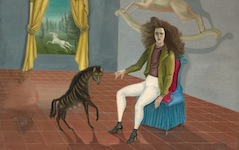
Carrington’s Self-portrait (c.1937-8)
A sketch-like landscape print by the nineteenth-century French artist, Camille Corot, includes the ghost-like echo of his own self-portrait in the trees at right.

Corot’s La Ronde Gauloise
See how Cranach represents himself as an evil man executing "his painting" of spiritual perfection.

Cranach’s Martryrdom of St. Barbara
A face formed from smoke in the Renaissance has been widely acknowledged as a veiled face

Cranach’s Portrait of Anna Putsch (1502-3)
Discover how two of Dürer's images are based on his own profile
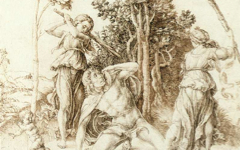
Dürer’s Death of Orpheus (1494) and Descent into Limbo (1510)
This is an example of a hidden face in rock being seen by others
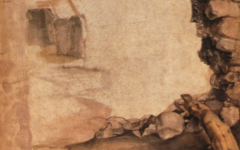
Dürer’s Mountain Hut in Ruins (1494-5)
See how Durer shaped the Virgin and Child into the form of his own monogram
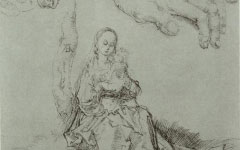
Dürer’s Virgin and Child (c.1491)
See how one form can metamorphose into another while bringing with it the form's original meaning
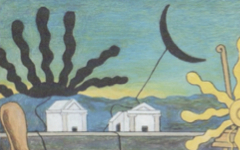
De Chirico’s Sun on the Easel (1973) Part 2
If you can't make a sense of an image beyond what it appears to be, keep looking until you can. Come back to it, time and again, until you do.

Degas’ At the Races in the Countryside (1869)
Veiled images are hidden in even the most simple and natural-looking sketches

Degas’ Galloping Horse (n.d.)
There is more to Degas' art than the mere copying of nature
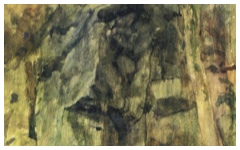
Degas’ Rocks and Trees at Bagnoles-de-l’Ornec (1867)
See what Degas makes of a Delacroix and thus, perhaps, what you should too....

Degas’ Study of Delacroix’s Entry of the Crusaders into Constantinople (c.1860)
See how the meaning behind this image changes our entire understanding of Degas' oeuvre
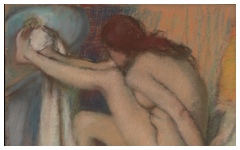
Degas’ Woman Drying Her Foot (1885-6)
Gauguin veiled his face so well in this woodcut that it has never been seen
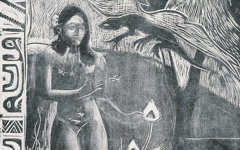
Gauguin’s Nave Nave Fenua (1893-4)
Find out how Gauguin's Vision after the Sermon is the Artist's
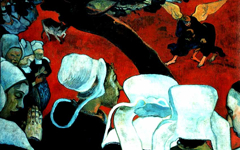
Gauguin’s Vision after the Sermon (1888)
If you think like the artist and think inwards, all changes...
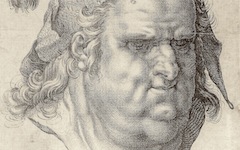
Goltzius’ Man Wearing a Tasseled Cap (1587)
With Mercury outfitted as a painter, the viewer can interpret this image confident that the subject is art
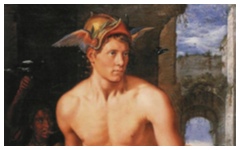
Goltzius’ Mercury (1611-13)
Sent on a mission to paint a potential queen for the blood-thirsty and dangerous Henry VIII, how did Holbein "paint" himself in painting the future Queen?

Holbein’s Anne of Cleves (c.1539)
If this were an illustration of the American Civil War as many believe, it would not be by Winslow Homer. It would be by a mere painter, not an artist.
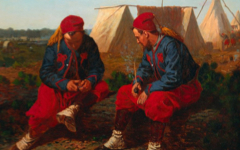
Homer’s Briarwood Pipe (1864)
Don't get misled by a charming scene. There's always more to see in the work of a real artist.

Homer’s The Boat Builders (1873)
What contemporary artists like Jasper Johns does is what great artists have always done. Those that do not will not last. A century from now they will be forgotten by all but historians.
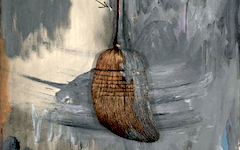
Jasper Johns’ Fool’s House (1964)
The universal features of Frida Kahlo's art are what links her to the canon, not the details of her private life
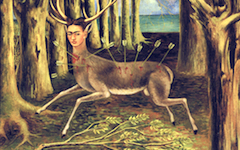
Kahlo’s The Wounded Deer (1946)
Find out how specialists have seen some of these underlying themes at work in Klee's prints

Klee’s Tightrope Walker (1923)
An obvious example of how later artists can see in an artist's work what we, ordinary viewers, do not.
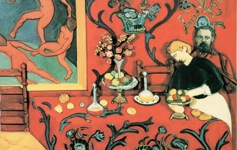
Larry Rivers’ Déjà vu and the Red Room: Double Portrait of Matisse (1996)
Leonardo dated this landscape drawing as though it was a realistic rendering on a particular day in 1473 though scholars are divided. Some argue that, yes, the castle on the left existed while others believe that the scene is imaginative and point out specific spatial inconsistencies to support their view.

Leonardo’s Landscape (1473)
© Simon Abrahams. Articles on this site are the copyright of Simon Abrahams. To use copyrighted material in print or other media for purposes beyond 'fair use', you must obtain permission from the copyright owner. Websites may link to this page without permission (please do) but may not reproduce the material on their own site without crediting Simon Abrahams and EPPH.
